June 18th was just another rainy day for my sister, Maria Guzman, owner of Standing Bear Farm Hostel, and her crew. They were used to the rain up here; it’s an eastern deciduous rainforest, after all. However, this year brought much heavier rainfall than usual, completely saturating the ground in the surrounding hills. This created the perfect conditions for the disaster that was about to unfold.
“It happened so fast”
What began as a typical rainy day transformed into a cloudburst unlike anything locals had ever seen. Maria, owner of Standing Bear Farm Hostel, shared that the Green family, who had lived in her house for generations before she bought it in 1998, always told her the two creeks flanking the property had never overflowed. Because of this, she had never considered the possibility of flooding.
Maria remembered intermittent rain showers throughout that week, which brought welcome relief from the heat. However, on the day of the flood, the heaviest rains started around 3:30 PM. A dark cloud appeared overhead, unleashing an unprecedented amount of rain in a short period.
On the day of the flood, Maria and her crew, Jarrid and Lost John, were waiting out the rain on the front porch. She soon noticed a few inches of water streaming down the driveway, covering their car tires by about two inches. Within minutes, the water turned muddy and rapidly grew into a raging torrent over two feet deep and rising fast.
As the house shook and shuddered, Maria told me that genuine worry began to set in. Unsure how much higher the water would rise, she envisioned them needing to retreat to the attic.
Never one to sit idle, she started grabbing sleeping bags, snacks, and axes, taking them to the attic. She reasoned they could use the axes to cut their way onto the roof if necessary. Her fears escalated, though, as she started to dread that if the water kept rising unchecked, she and her crew would be swept away on the roof, heading toward their deaths.
The Viral “Pray For Us” Video
With all these scary thoughts floating through her mind, she felt the need to record this flood on her phone. “I felt like this might be my last time to get to do that,” she shared, adding that she strongly felt the need to ask for prayers. “I felt that was all I had left and I was having thoughts of all the things I wanted to do before I died, and I didn’t want to leave my work undone.”
Right after filming that short video, she sent it to her daughter, Mahala Owen. Mahala immediately called to ask what was happening, but their call suddenly cut out.
Concerned, Mahala then dialed 911. The operator’s first question was, “Are you calling about the house being washed away?” While Mahala initially wasn’t sure of the video’s full gravity, the mention of a hostel “being washed away” significantly heightened her alarm for her mother’s safety.
Mahala promptly shared the video on Facebook, hoping comments would provide more information. Her intention was not to gain widespread attention, but the video quickly went viral, racking up over four million views in a short time.
Surprisingly, after her daughter shared the video, Maria said she felt a sense of comfort and calm, believing that everyone’s prayers were being heard and that they would be okay.
Another hiker, David Piper, who managed to get to the safety of the road, filmed a dramatic video of the flood.
“No time to panic”: Jerrid’s Story
Rarely do you ever see Jerrid Bogard without his steadfast companion, Enola. Photo: Jerrid Bogard
Jarrid Bogard, the hostel’s lead support staff and building projects manager, told me that some people on the hostel’s Facebook page criticized them for being unprepared or for having a hostel in a potential flood zone. However, a flash flood of this magnitude was unprecedented; no one could have anticipated such a disaster here.
After a few hours of sudden, heavy rains, the two streams on either side of the hostel began to rise sharply without warning. Jarrid remembered, “I had just walked out into the front yard to get the pork roasts from the smoker. By the time I had them on the table and was slicing them, I looked back and the entire smoker was floating away.” That’s when he knew things were getting serious.

The very cool and laid back, “Lost John”, NOBO class of 2022. Photo: Arnold Bloodhound Guzman
Instead of panicking, Jarrid and Lost John, a 2022 thru-hiker who was helping with bathhouse construction, grabbed a saw. They walked to the dry part of the yard and felled a tree across one of the creeks, creating an escape route into a blackberry pasture in case they needed to evacuate.
Not wanting only one way out, Jarrid then tied a 12-gauge extension cord around his waist and stepped into the nearly three-foot-deep, raging river that was surging through the driveway. Maria had described it as “Class 4 rapids.” With Lost John holding and feeding out the cable, Jarrid bravely waded across the eight-foot-wide driveway, tying the cord to a point on the upper foundation of the resupply building. His plan was for them to wade across the driveway to higher ground.
“I really wanted to have more than one means of escape,” he explained. The lower escape route, he noted, led into a dense blackberry bramble, which none of them looked forward to navigating and intended only as a last resort.
Help is On the Way!
Before the moment that Maria sent the famous “Pray for us” video, Cocke County Emergency Services were already in action.
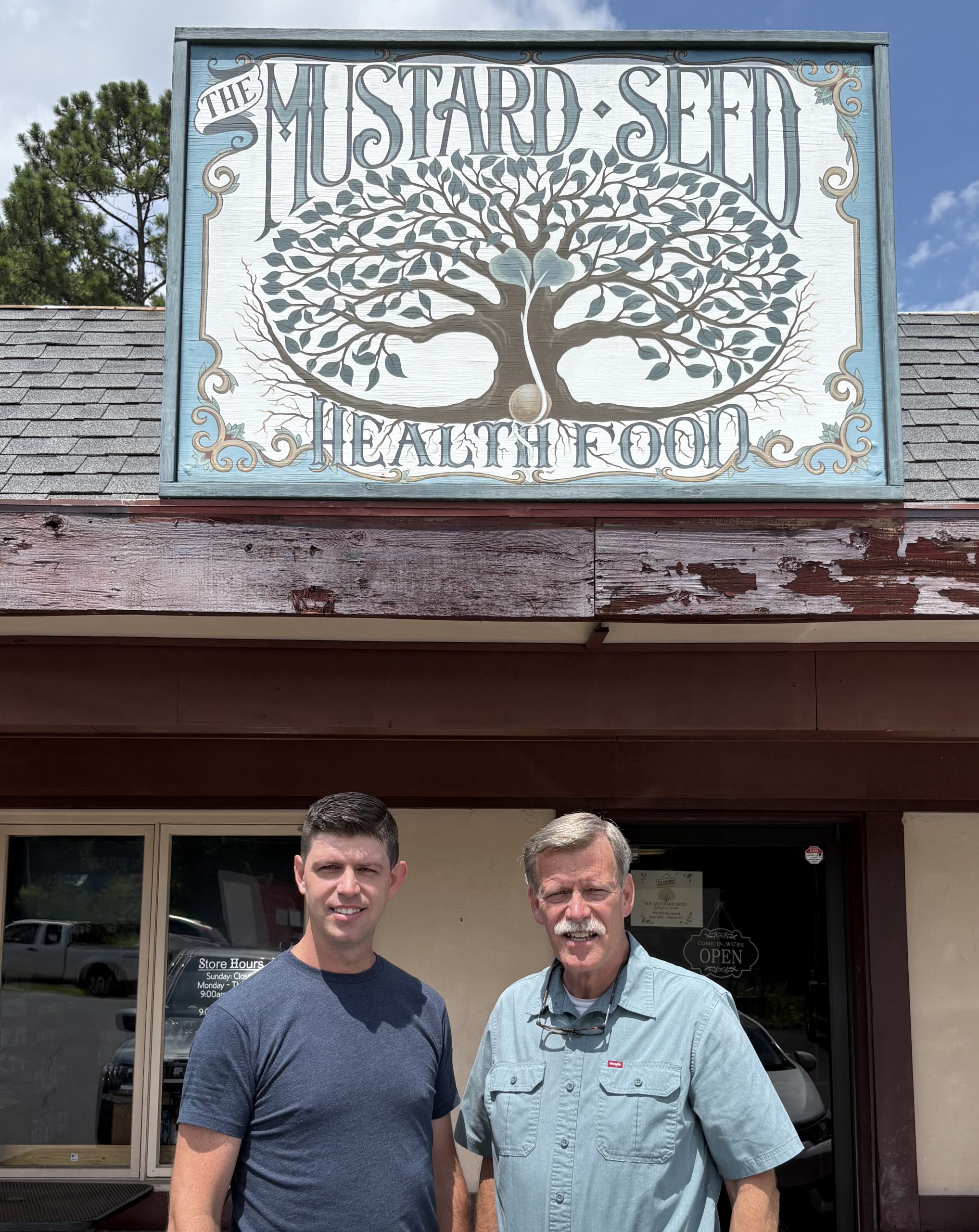
Grassy Fork Volunteer Fire Department Chief, Walter Cross (Right) and his son, Captain Walter Cross II. When they are not responding to emergencies, they run a thriving health food store in nearby Newport, TN. Photo: Arnold Bloodhound Guzman
Recently I spent an afternoon speaking with Captain Walter Cross II about this fateful day. What I learned was a moving story of a quick, well-organized response, inter-agency coordination, and heroism.
The Grassy Fork Volunteer Fire Department, headed by Chief Walter Cross, and his son, Captain Walter Cross II were already on alert at their fire station in Hartford TN, (exit 447) just down the road from exit 451, where Standing Bear is. In describing the events of the day, Captain Cross gave me a play-by-play of the unfolding of events.
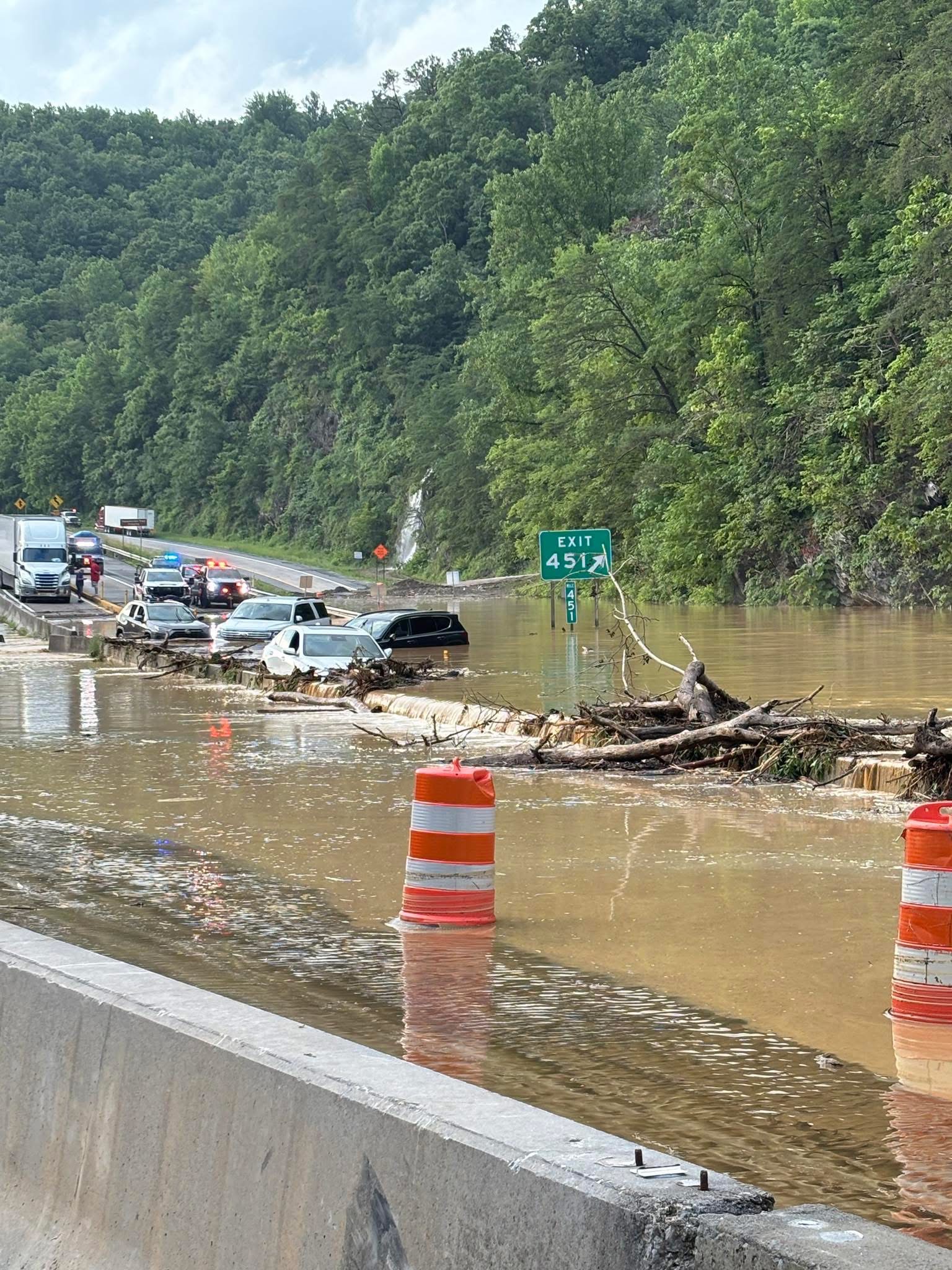
This exit, and the section of Appalachian Trail that passes beneath the bridge, was completely submerged. Photo: Walter Cross II
On the afternoon of the cloudburst, the Cocke County Emergency Management Agency began receiving distress calls from stranded motorists on I-40 and reports of extensive flooding on Green Corner Road. In response, they dispatched the Grassy Fork Fire Department and the Cocke County Swift Water Rescue Team to the area.

Though everyone caught in submerged cars had reportedly self-rescued, the Swift Water Rescue team’s protocol was to thoroughly check the vehicles just in case. Photo: Walter Cross II
Captain Cross told me he found it odd that there were no heavy rains in his immediate area. His phone’s Doppler radar only showed a small blip hovering over the Green Corner Road community.
Unsure if Green Corner Road was passable, they wisely decided to send another group of firefighters through winding mountain roads to reach it from the back way, just in case the main route was blocked.
Meanwhile, Walt and his crew had only traveled a couple of miles before finding the roadway blocked at mile marker 450, about a mile from their destination, Exit 451, where Standing Bear is located. They encountered something no one there had ever seen: a massive river of water cascading down the steep gorge sides, ending in a huge waterfall that dumped thousands of gallons onto the road. Several submerged and disabled cars sat around the base of this waterfall.
He believes the only reason these cars weren’t swept away was due to the modular concrete barriers along the roadway. Otherwise, the people in those cars could have been swept off the road and plunged 140 feet down a near-vertical drop into the Pigeon River Gorge below, likely resulting in deaths or serious injuries.
A Well-Coordinated Effort
Captain Cross reported they were receiving more flood alerts ahead, with additional cars and trucks reportedly disabled at Exit 451. Before reaching that point, they first needed to clear the disabled vehicles from the waterfall at Mile Marker 450.
Fortunately, the Tennessee Department of Transportation (TDOT) was already en route with a large track hoe. The TDOT track hoe lifted the disabled cars one by one, like toys on a heavy-duty steel chain, quickly clearing the roadway. Afterward, the track hoe began lifting some concrete barriers, allowing the pooled floodwaters to flow harmlessly into the Pigeon River Gorge below.
Once the road was clear, the rescue vehicles proceeded to Exit 451. There, they encountered something else unprecedented: a deeply flooded roadway at the bridge where the Appalachian Trail passes underneath, with several cars submerged in the middle. The water below the bridge was so deep a hiker would have needed to swim to cross and continue their thru-hike.
Even though everyone in the submerged cars was reported to have self-rescued, the Swift Water Rescue Team still paddled out on their raft as a precaution to check for any stranded motorists.
“I wasn’t prepared for this level of devastation”.

There’s a new waterfall in Tennessee! Unfortunately, this waterfall was directly in the middle of Green Corner Road. Photo: Walter Cross II
While the water rescue at Exit 451 was underway, Captain Cross’s team finally made their way up Green Corner Road to check on Standing Bear Hostel. They quickly found the gravel road completely destroyed and impassable in one section. The torrents had gouged out what could only be described as an eight-foot-deep canyon in the middle of the road, scouring most of the soil down to bedrock all the way to the interstate.
Meanwhile, the other rescuers, approaching from the back way, also encountered sections of Green Corner Road washed out and impassable for their emergency vehicles. At this point, the decision was made to deploy the SWAT team with their MRAP military-style SWAT vehicle. Its super-high clearance offered the best chance of reaching the hostel.
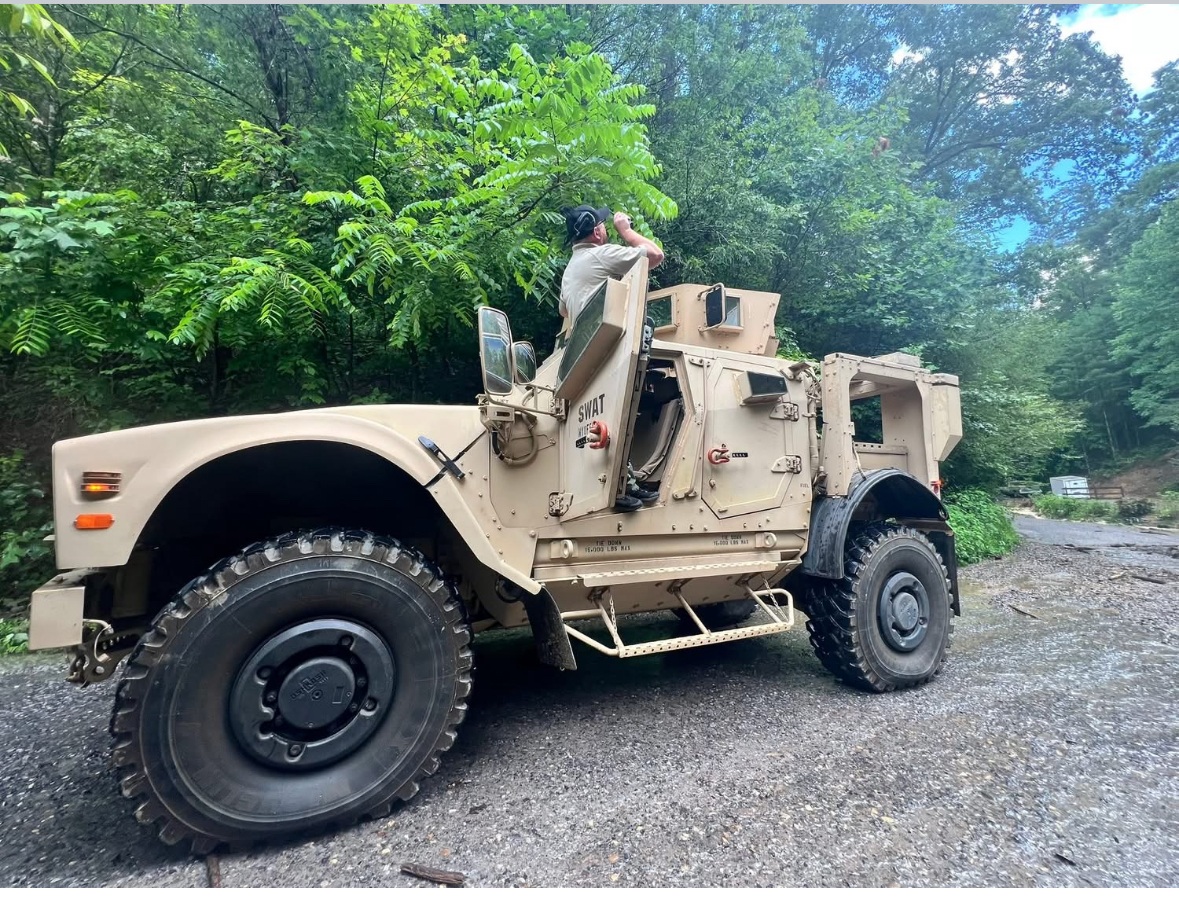
Maria and crew were very happy to see their “ride” coming to take them to safety. Photo: Standing Bear Farm
By the time the MRAP reached the sections of road where culverts were washed away, members of the Swift Water Rescue team had to walk ahead to ensure the water wasn’t too deep. With these brave rescuers wading in nearly chest-deep, rushing waters, the MRAP successfully crossed these watery obstacles and reached Standing Bear Hostel.
Captain Cross mentioned they learned a great deal from last year’s devastating Hurricane Helene. Various emergency services discovered improved ways to coordinate between agencies for better responses to future natural disasters.
Although the waters were slowly receding at Standing Bear Hostel, Maria and her crew had initially considered staying. However, with many trees and power lines down, the threat of landslides, and more thunderstorms looming, they made the sensible decision to evacuate.
The Aftermath
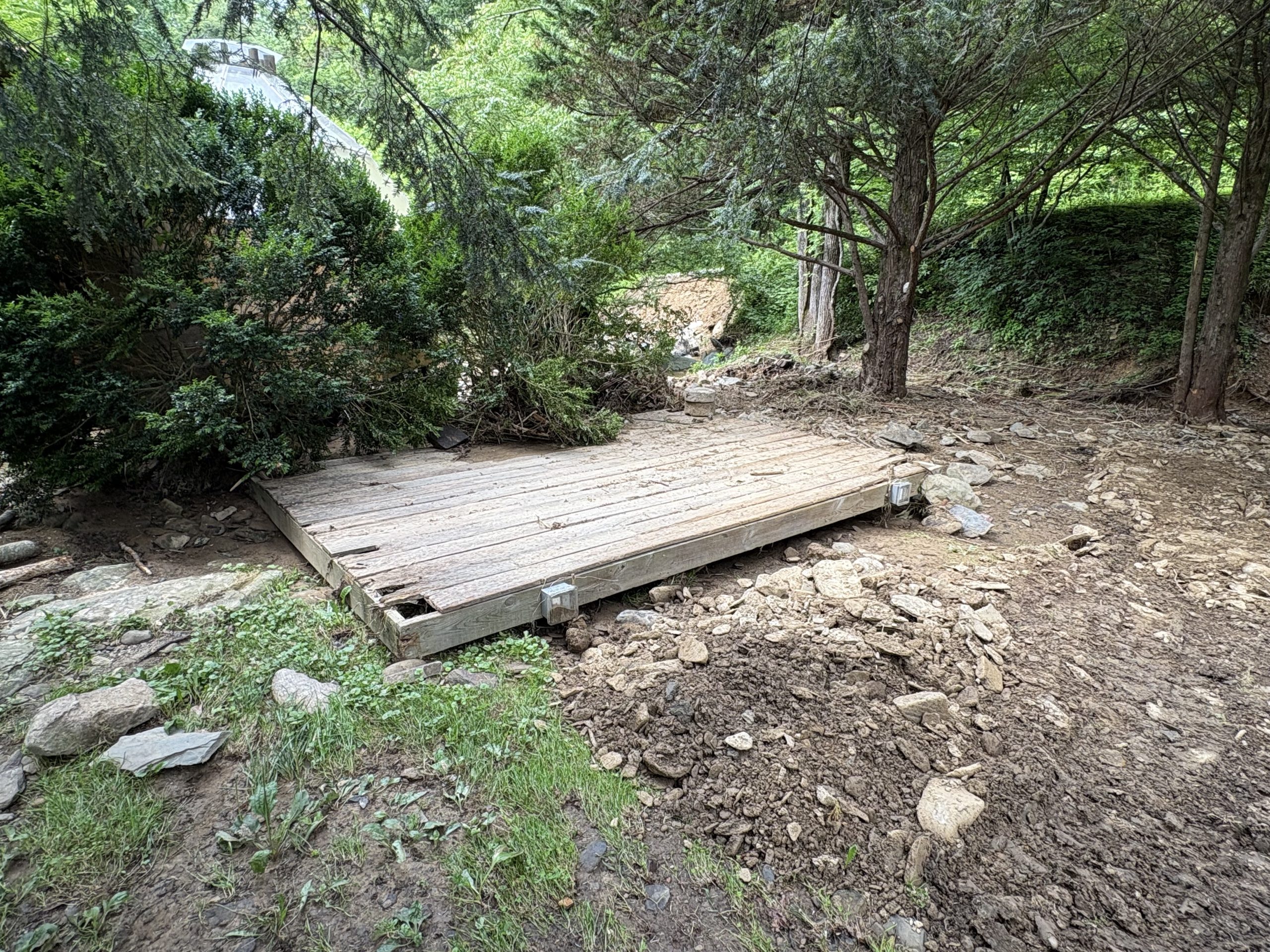
What was left of the band’s stage, found lodged against a tree over 100 foot away from its original position. Photo: Arnold Bloodhound Guzman
Local accounts suggest an extraordinary amount of rain fell during the Standing Bear Flood. Lost John’s informal measurement with a 5-gallon bucket, filled to within a few inches of the top, indicates a rainfall total of roughly 15 inches. This localized heavy rain was described as a “cloudburst” and an “unprecedented amount of rain in a short amount of time.”
While official, precise rainfall totals for the specific microburst event at Standing Bear Farm and Hostel are difficult to pinpoint, various news reports from June 2025 confirm that the area experienced “severe weather,” “extensive local flooding,” and “heavy flooding” following a microburst storm. The sheer volume of water caused significant damage, with creeks turning into “rushing rivers of mud, rocks, and debris,” and buildings becoming “several feet underwater,” consistent with the high rainfall estimate provided by Lost John.
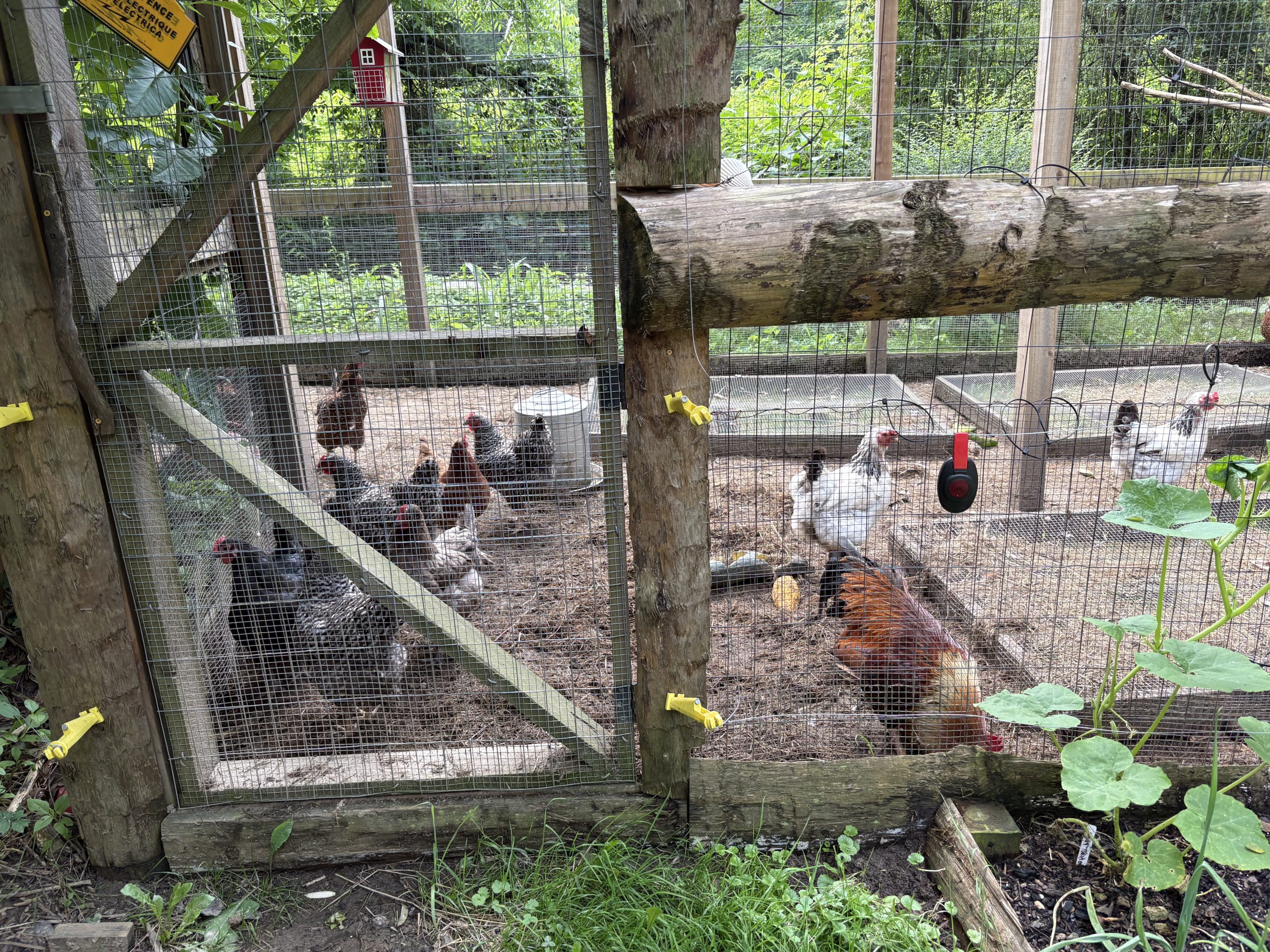
Miraculously, the egg laying ladies escaped the flooding. Photo: Arnold Bloodhound Guzman
They found that the condition of the house and the outbuildings was not too bad. Though the main house had some mud seepage through the walls, the foundation and structure remained intact. Except for one junky little storage shed getting washed off its foundations and smashed by the floodwaters, the rest of the outbuildings—bunkhouse, kitchen and cabins—were in similar shape as the main house: muddy but unharmed.

This old shed was the only building to get destroyed. It was washed off its foundation, pushed 30 feet downstream until it lodged against one of the creekside cabins. Maria credits it for saving the cabin, for it diverted the worst of the floodwaters around the cabin. Photo: Arnold Bloodhound Guzman
The 3 porta-potties, the band stage, and the propane tank all washed away and had gotten stuck in trees at the lower end of the property. There was even an extremely heavy industrial chain that had been washed away and wrapped around a tree.

A few miles away from Standing Bear, the levee on this duck pond blew out. Photo: Arnold Bloodhound Guzman
Unfortunately, not only was Standing Bear Hostel damaged by the flood, but neighbors within a 5-mile radius suffered washed out culverts, severe damage to driveways, and one farm had a duckpond levee breached and wash away.
Cleanup Begins—God Bless the Volunteers

The 9th graders from Raleigh, NC working hard in the sweltering heat. Photo: Mahala Owen
The day after the flood, a church group from Asbury Church in Raleigh, NC, heard about the need at Standing Bear. This group, made up of several high school freshmen and their adult leaders, was already in the Hot Springs area helping with rebuilding efforts after last year’s Hurricane Helene. They diverted their team to the hostel to help with the cleanup. Adult leader Jeanne Pugh and her “Rising Freshmen” all pitched in. They used shovels, rakes, and wheelbarrows to tirelessly clear mud and debris from areas the skid steer and tractor couldn’t reach, working hard in the hot sun.

77 year old former thru hiker, Red Hat, proves that everyone has contribute. Photo: Arnold Bloodhound Guzman
Simultaneously, many other community members rallied, bringing in heavy equipment. They began the difficult task of clearing countless tons of rock, mud, and debris that had completely blocked the driveway.

Volunteer, Chrissy Miller, driving the skid steer like a boss! Photo: Mahala Owen.
Fortifying for the Future
Jarrid stated their immediate concern is digging out the creeks and constructing more retaining walls along them. The flood not only eroded the creek banks with rocks and mud from upstream, but also significantly raised the elevation of the creek bed. This means any future floods would more easily overflow the banks. To fix this, he plans to rent a backhoe for the extensive work of deepening the channel.
How Can People Help?
According to Jarrid, while money is always welcome, the immediate need is for workers to tackle a variety of tasks. Some heavy work involves shoveling and hauling debris, and building retaining walls. Lighter work is also necessary to remove drywall and clean water and mud that infiltrated the exterior walls on the flooded side of the house.
Beyond that, thousands of smaller tasks need doing: cleaning appliances, furniture, and floor surfaces in all outbuildings, removing ruined carpets, hauling off more debris, and much more. They desperately need volunteer tradespeople with diverse building experience, especially in masonry and carpentry, to help get the hostel operational again.
Repairs to the hostel are expensive. On top of that, weeks of closure have meant significant lost revenue. Maria is grateful for the outpouring of support through crowdfunding campaigns, especially since they don’t qualify for FEMA money and lack flood insurance.
There is soon to be a local benefit dinner with live music to raise more money for the rebuilding and fortifying of the hostel so that it will always be there for future hikers to enjoy. The details of this are on the Standing Bear Farm Hostel Facebook page. They also are selling a tee shirt to commemorate the flood, also found on their Facebook page.

Year of the Major Floods
With such cataclysmic floods happening in Texas, New Mexico, and others all around the country, the weather patterns seem to suggest that this could be happening more often.

Standing Bear Farm Hostel owner/operator, Maria Guzman and her daughter, Mahala Owen, weary from all the backbreaking work of cleanup. Photo: Arnold Bloodhound Guzman
Maria shared that even though the worst of the devastation is over, she will forever cast a wary eye toward the sky each time a dark storm approaches, living in fear that what happened before could happen again.



